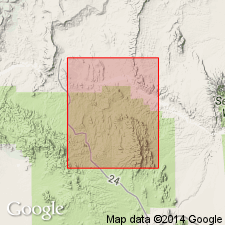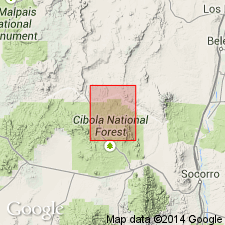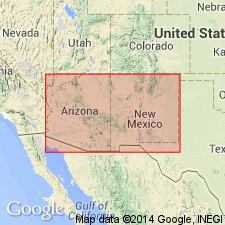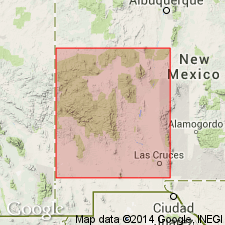
- Usage in publication:
-
- La Jara Peak member
- Modifications:
-
- [First used]
- AAPG geologic province:
-
- Orogrande basin
Summary:
La Jara Peak member of La Jara formation. Composed of flows and flow breccias of basalt in lower parts and basaltic andesite in upper part. Overlies Hells Mesa member (new); underlies Santa Fe formation. Present in southwestern New Mexico. Age is late(?) Miocene.
Source: US geologic names lexicon (USGS Bull. 1200, p. 2076).

- Usage in publication:
-
- La Jara Peak member
- Modifications:
-
- Original reference
- AAPG geologic province:
-
- Orogrande basin
Summary:
[preprint? 1954?] Pg. 26, 30-32, fig. 2, pl. 1. La Jara Peak member of La Jara formation. Flows are dark- to medium-gray aphanophyres, which are in part red, oxidized, and scoriaceous. Lower part of member has distinctive red speckled appearance. Horizonal sheeting common, giving rock stratified appearance. Crude columnar jointing developed in more massive outcrops. Flow breccias, as well as block flows (aa type), abundant throughout section. Three volcanic sandstone and conglomerate beds intercalated in uppermost part of member. Consists of a number of flows; exact number not determined. Maximum thickness about 2,500 feet. Type section contains 1,175 feet of lava and 25 feet of intercalated volcanic conglomerate and sandstone. Present in southwestern New Mexico. Age is late(?) Miocene.
Type section: measured in northern Bear Mountain, in secs. 27 and 34, T. 2 N., R. 5 W., 3 to 3.5 mi south-southwest of La Jara Peak, Puertecito quadrangle, Socorro Co., NM. Named from La Jara Peak in secs. 11 and 14, T. 2 N., R. 5 W.
Source: US geologic names lexicon (USGS Bull. 1200, p. 2076).

- Usage in publication:
-
- La Jara Peak Andesite
- Modifications:
-
- Paleomagnetics
- AAPG geologic province:
-
- Orogrande basin
Summary:
In the Bear and Magdalena Mountains, Socorro Co, NM, Orogrande basin, flows of La Jara Peak Andesite are found to be normally magnetized. These are underlain by Hells Mesa Rhyolite ash-flow tuff, which is reversely magnetized and correlated with Tadpole Ridge Formation. Magnetostratigraphic position of La Jara Peak, Hells Mesa, and Tadpole Ridge units within a preliminary model of the middle Tertiary paleomagnetic reversal pattern is depicted on fig. 4.
Source: GNU records (USGS DDS-6; Denver GNULEX).

- Usage in publication:
-
- La Jara Peak Basaltic Andesite
- Modifications:
-
- Overview
- Geochronologic dating
- AAPG geologic province:
-
- Orogrande basin
- Basin-and-Range province
Summary:
Occurs in a major shield volcano in Bear Mountains, probably Socorro Co, Orogrande basin and Catron Co, Basin-and-Range province. Equivalent flows are present across north edge of Mogollon-Datil field from Datil Mountains to Joyita Hills. La Jara Peak itself is a volcanic neck, but that feature is a Pliocene basalt unrelated to La Jara Peak Basaltic Andesite, a name retained only because it is so well established. Consists of sparsely porphyritic, fine-grained basaltic-andesite lava which is continuous in some areas and interfingers as tongues in other areas. Commonly contains small, red, deuterically altered ferromagnesian phenocrysts. Includes the informal basaltic andesite of Cerritos de las Minas and the andesite of Rosa de Castillo. Present in Lemitar, Bear, Gallinas, and Magdalena Mountains, and in Joyita Hills. Overlies La Jencia Tuff (new) and underlies Popotosa Formation of Santa Fe Group. Intertongues with Vicks Peak, Lemitar, and South Canyon Tuffs. Age ranges from about 31 to 24 m.y. on basis of nine K-Ar whole rock dates on flows and dikes in La Jara Peak and on ash flow sheets interbedded with tongues of La Jara Peak. Assigned to the Oligocene.
Source: GNU records (USGS DDS-6; Denver GNULEX).
For more information, please contact Nancy Stamm, Geologic Names Committee Secretary.
Asterisk (*) indicates published by U.S. Geological Survey authors.
"No current usage" (†) implies that a name has been abandoned or has fallen into disuse. Former usage and, if known, replacement name given in parentheses ( ).
Slash (/) indicates name conflicts with nomenclatural guidelines (CSN, 1933; ACSN, 1961, 1970; NACSN, 1983, 2005, 2021). May be explained within brackets ([ ]).

